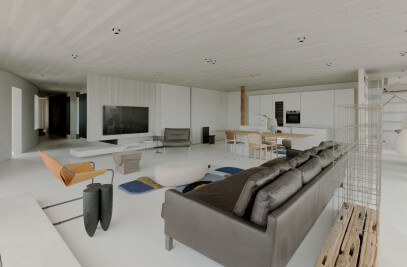Residence, a construction of life’s memories.
The “Din-a-ka”, or covered walkway, was a distinct cultural and architectural feature in the early days of Taiwan’s agrarian society. It was the place for social exchanges in rural life. In the rapidly changing social landscape, Din-a-ka is an obscure feature, rarely found these days outside fond memories of the past.
The curved structure in the hallway provides a smoothness and variance to the circulation, in addition to its storage function. Using a sculptural process, the designer gave the curve’s facade a weathered and aged appearance, adding rusted metal and gold foil to the grayish black material. The curve, lit by strip lighting and the parallel wall paneled with aged Taiwan cypress (Hinoki) form a passageway, as if it is leading back in time. Green mountains visible in the distance and native trees on all sides, combined with the style and arrangement of furniture in the open layout, blur the boundaries of the space. The indoors and outdoors seemingly meld as one. A steel blue cabinet floating in the entry marks the indoors, and directs the circulation.
Incorporating different styles of furniture breaks the spatial restriction. Customized lighting hangs from the ceiling; one is a square shape and the other is a simple rod shape, embellishing different spaces and satisfying different lighting functions. The fully glassed exterior-facing wall of the watshitsu room, for meditation and serving tea, brings the trees and scenery indoors. Concrete textures and warm wood tones form the basis of the master bedroom: simple and elegant; the entire space reveals a calm and quiet ambiance. The guest bath is presented in a somber black palette. Against a textured wall of stucco, an organically-shaped solid pecan wood table is suspended by copper supports.
This 160m² space displays an abundant variety of materials. Once again, the essence of minimal design, the significance of proportion in modernist spatial partitions, the minimalist aesthetic concept of the Song dynasty and its elegant details and atmosphere, as well as the Wabi-Sabi aesthetic culture are all manifested seamlessly and harmoniously in this space.
ABOUT MATERIAL;
- Recycled wood, cement mortar, terrazzo bear the memory of the past but appear in creative ways.
- Furniture pieces are light-weight and easily moved from one place to others.
- Light color wood material dialogue with the rustic cement surface.
- Sharp contrast in color and material between the guest bathroom and master bathroom.
ABOUT the owner and communication note
- The design for a retired couple demanded a harmonious dialogue with the great natural surroundings in the Beitou district.
- Arcade is a place where social activities are held in the traditional city and its concept is represented in this house as a hint to make good linkage among family members.
- Local elements are identical everywhere in this apartment.
- Storage is hidden without violating visual consistency.


































